This biography consists of two books, one a 344 page text version with only 40 photos (Mark Donohue: Technical Excellence at Speed) and a second volume, ( Mark Donohue: His Life in Photographs) consisting of photographs with relevant captions. Each one is priced at $39,95 USD. First we review the text volume, then, Sabu Advani reviews the photo book.
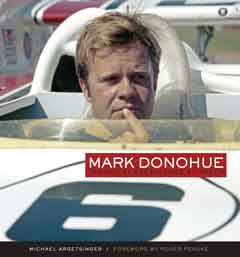 Mark Donohue: Technical Excellence at Speed
Mark Donohue: Technical Excellence at Speed
by Michael Argetsinger
David Bull Publishing, 2009
Forward by Roger Penske
344 pages, 25 color & 15 b/w photos
List Price: $39.95/£25.99
ISBN-13: 978-1 935007-02-9
Order Here
Review by Pete Vack
Michael Argetsinger has written a remarkable and fitting tribute to one of America’s greatest race drivers. That it has already won several awards including the prestigious International Automotive Media Award for the Best Book of 2009 is to be expected; Agetsinger’s previous work, Walt Hansgen: His Life and the History of Post War American Road Racing was similarly praised and feted in 2006 (read review).
Let there be no doubt that this is a significant book fully worthy of the IAM Awards. In a full-time effort that required more than three years to complete, Argetsinger interviewed over 211 people close to the subject, and enjoyed not only access to all the family papers but those of the Penske organization as well. He also had access to the unpublished tapes made for Donohue’s own book The Unfair Advantage. In fact, his approach to the Donohue biography is much like that of the Donohue/Penske approach to racing–a total commitment, the pursuit of perfection, and a successful outcome a done deal even before the checkered flag. “Although I hadn’t thought of it that way,” said Argetsinger in a phone interview, “I always had in mind that if I did this book, I would have to do it in a manner that Donohue would have appreciated.” Argetsinger knew that it HAD to be good; anything less that the best would not have been par for the course.
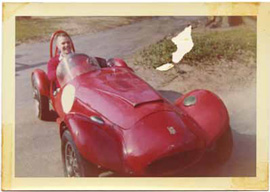
At the very beginning: Mark in Burge Hulett's Bandini. From the book, Mark Donohue: His Life in Photographs.'
Carl Goodwin, an excellent automotive writer on his own and a member of the IAMA board, said that Argetsinger used Donohue as the focal point but “used such a broad brush that the book ends up being a chronicle of sportscar racing in America during one of the most interesting (and dangerous) eras in motorsports history.” Since drivers of the era were truly multi-taskers, the book covers a wide variety of racing: SCCA production racing with an Elva Courier; early years of Formula Junior with an Elva; Formula Libre with a Cooper-Offy, Trans Am racing with a Mustang, Camaro and AMC, Can Am with a Lola, McLaren and Porsche, Le Mans with Ford GTs, Sebring with a Ferrari 512M, the Indianapolis 500 (where he won in 1972), and finally, Formula One with the Penske PC1 and March 751.
Argetsinger also tracked down everyone he possibly could who might provide insights about Donohue’s early years, but tragically, Mark’s sisters both died young, well before the book was even contemplated, while his mother passed away in 1993, ten years after Mark Sr. Those details of early family life are rare…there are few letters, documents, papers to fill in the gaps. Argetsinger found Mark’s boyhood friends to be helpful. Donohue’s penchant for pranks obviously began at an early age, as did his focus on cars, mechanics and speed. The Donohue family was well off, and bought Mark a new 1957 Corvette, which he drove across country to a summer job with the Diamond Match company in far off Cloquet, Minnesota–things we may not have guessed about his younger days. But we’ll not know, for example, if there was that ‘aha’ moment when as a boy, he knew that cars would shape his life, or what influences really had an effect on his future (although it may have been when Mark went ice racing with his new ‘Vette.)
The book gains in strength as Donohue grows and his circle of friend increases, until by the end, you felt like you’ve been a part of the race team. The depth of the research is amazing. On the surface, this could be seen a merely a blow by blow recounting of each of the races Donohue participated in from 1960 to 1975, similar to almost every other race/bio book ever written. But with Argetsinger, the events read as if he was actually at each race, behind the scenes with the crew, taking notes, recordings and talking with family members. He writes about the car, the garages, the trips, the incidents, the anecdotes, the jokes, the problems, the failures and successes at each event, not only in relation to the Penske team but to the direct and often indirect competitors, such as the brutally competitive Parnelli Jones Mustang team or Dan Gurney’s AAR. He gets as much out of the remnants of the opposing team members as he does Penske’s and compares notes. There are also two sides to every story and “Captain Nice” (why do they call me that, Donohue wondered. “I always heard nice guys’ finish last.”) was not always in the right lane. Although the account is usually tipped toward Donohue and the Penske team, feuds with Parnelli Jones and Pedro Rodriquez (a personal friend of Argetsinger’s) and Peter Revson are told from both sides as possible. Argetsinger goes well beyond what is necessary; he is a Master of telling the story of American road racing, weaving in the politics of the SCCA amateur vs. pro battles, the rise and fall of the Can Am series, Indianapolis rookie trials, and the financial failures of the big tracks like the ill fated Ontario Motor Speedway. Darkly, the constant presence of death–almost unknown in today’s racing–is handled with understanding and taste. But the toll was tremendous and eventually included Donohue himself.
Argetsinger leaves no wheel unturned in a relentless and gratifyingly complete attempt to get the record straight. It is this superb attention to detail and commitment to excellence that puts “Donohue” far, far above the average race driver’s bio. Donohue would have been pleased.
On the downside. Any book of 344 pages can get tedious. Fortunately Argetsinger’s writing skills keep the interest up, and one is eager to find out what happened at the next event and further. But it is long, and is not an overnight read by any means.
Someone who may just buy the text book volume off a shelf may not know that there is an accompanying photo book, as there is no mention of it in the text volume, which is unusually short of images.
Notes and bibliographies are missing. The book is packed with first-person quotes—we can assume that when Argetsinger does not attribute a quote to any other source it defaults to his own interviews, letters or emails to the individual quoted. Argetsinger discussed this with the publisher David Bull and it was decided that since in almost every case the quote in question was attributed in the text or acknowledgements, there was little need for further documentation. As historian Michael Lynch mentioned “It’s unfortunate that documentation standards have lapsed, but realizing the low volume sales of automotive biographies, we are very lucky to have the Donohue book in any event, with or without footnotes.” Still, a book properly documented will have a much longer shelf life than one that doesn‘t. Offsetting this is a comprehensive list of interviews in the Acknowledgements section, a full and useful twenty-four page Index, and Donohue Race Results by Year Appendix. At only 39.95 plus shipping, this book is an outstanding value and a must have for any student of racing history.
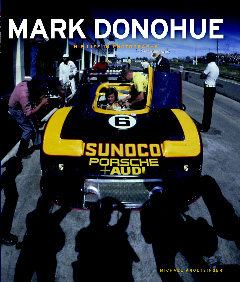 Mark Donohue: His Life in Photographs
Mark Donohue: His Life in Photographs
by Michael Argetsinger
David Bull Publishing, 2010
160 pages, 118 color & 126 b/w photos
List Price: $39.95/£25.99
ISBN-13: 978-1935007-09-8
Order Here
Review by Sabu Advani (speedreaders.info)
Publisher David Bull clearly has his fingers on the pulse of what readers want—and are able to afford. His books are not cheap but there hasn’t yet been a case of a David Bull book not being good value for money. Still, Bull’s desire was to keep the price of the Dononue text book to under $40 and, since it runs to a hefty 250,000 words, the only way to achieve it was to cut back the number of photos. So, for the reader able and willing to plunk down another $39.95 the 40 photos in that book can be augmented with a companion volume by the same author containing almost 250 photos! (And if that’s not enough you can buy it in a limited Publisher’s Edition of 300 copies that adds another 16 pages of photos and is also signed by the author and seven of Donohue’s closest Penske Racing associates: team manager Chuck Cantwell, engineer Don Cox, fabricator Ron Fournier, crew chief Karl Kainhofer, Sunoco engineer Jerry Kroninger, timekeeper Judy Stropus, and mechanic John Woodard. $99.95) Now you have the option to “pay as you go” rather than being forced to buy one expensive $80 book.
Being specifically a photo book, its format is enlarged to 9 x 11″. Argetsinger reviewed thousands of photos from professionals and civilians and selected those that best fit the arc of the story (told chronologically) and then had Donohue’s family and colleagues provide background and quotes for some of those photos. A complicated approach but the result is a highly customized, rich tapestry. Readers with an interest in bookmaking will find much to marvel at in this book. From the color of the headbands to the selection of complementary typefaces, styles and colors, designer Tom Morgan shows an admirably sure hand in balancing purpose with restraint.
Each of the four parts has a short introduction and is then subdivided into chapters that consist solely of photos with very, very detailed captions that go far beyond merely describing the scene at hand. While the book is not intended to take the place of a proper biography, there is sufficient information here to give the proverbial bird’s eye view of the man and his times, from early childhood to his death at the 1975 Austrian GP.
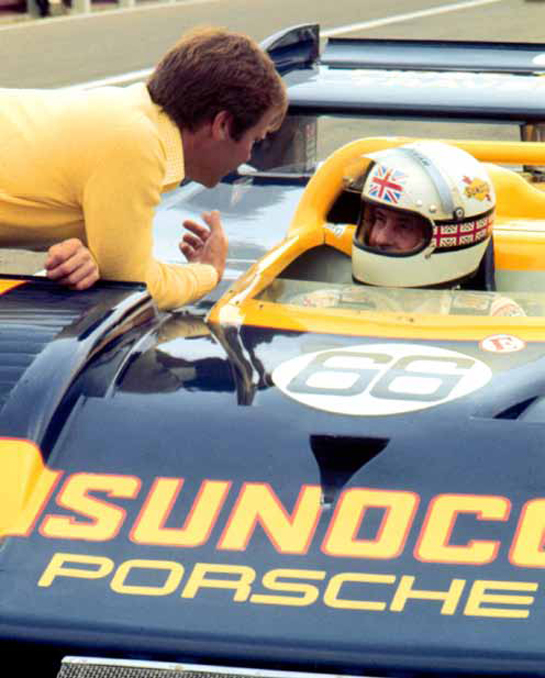
Another selection from the book 'Mark Donohue, His Life in Photographs', shows Donohue discusses tactics with Brian Redman, who wrote this caption: 'Mark, who was retired at the time, was the team manager, and he was obviously unhappy. I don’t blame him. Seeing me in the 917-30, which he had made into such a great race car, must have been a bit like someone else being in bed with your wife.'
A biographer faces a multitude of choices as to how to portray his subject in a way that is truly representative and also free of the projections the biographer inevitably brings to the task. That Argetsinger, himself a racer and from a racing family, understands not only Donohue’s profession but the man himself is evident in this: If you knew nothing about Donohue and all you had is these photos from which to form an idea of the man, based on purely visual cues such as body language, facial impressions, mannerisms and the observable dynamic between protagonists, you would surmise that Donohue was quiet, pensive, deliberate, an observer, not grouchy, usually at ease. And you’d be right. Because he was, and because Argetsinger got his portrait right.
Donohue set new standards in his sport. In the era in which raced, technical innovation far outpaced safety measures. It was 1974 when he said, “If I get wiped out and they carry me away, I wouldn’t expect anybody to feel sorry for me. It’s something I know is a possibility. I’m not complaining.” A year later it came to pass. Read the last sentence in the book, look at the last picture, and allow yourself to be moved.
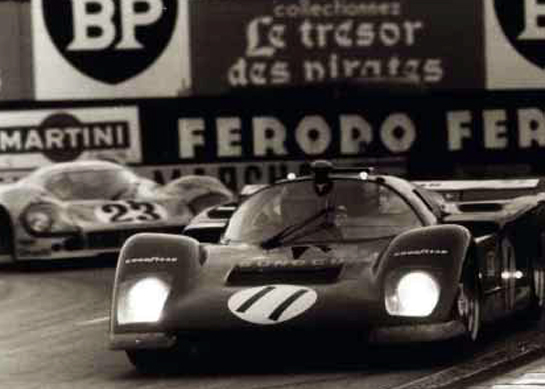
mark & i were near neighbors in morristown (NJ) environs.
i do not remember the bandini (do remember burge hulett however) but i do recall his elva courier which was prepared by lou schultz of S&R service over on rt.10. this was around 1959-61.
i stayed in club racing & mark went on to greater things. he received a lot of help from walt hansgen, among others. walt and randy pearsall had a service station over near bedminster, there was a very pretty cisitalia coupe kept in the garage. randy had a carrera panamericana veteran (i think 1954) lincoln sedan that i occasionally borrowed as a tow car when my own was out of action.
i think walt thought highly of mark’s commitment to motor racing but had reservations about my commitment.
> jack
Thanks for the photo of Mark in the Bandini Siluro (Torpedo) that I used to own. I bought it from Bob Satava in Ohio years ago and Burge Hulette was one of the listed owners. The car was originally ordered by Hank Rudkin ( Pepperidge Farm Bakery) in Norwalk Conn. The car is easily recognized because it is the only RHD Siluro that was built and for the horrible roll bar ( seen in the picture) that was still on it when I bought it. Hank ordered the car without an engine and put a Crosley mounted to an MG TC gearbox in it after it arrived. Shortly thereafter he installed a 2 Cyl Saab to make it more competitive. I brought it to Europe and it now resides nearby in Desenzano del Garda. Had I know of its Donahue history I would have asked for more $$$$.
I also spent a lot of time with the Sunoco Ferrari 512S / M., but that’s a story for another day.
Saluti from Italy Stephen
Actually there were two RHD Siluros both belonging to Hank Rudkin, yours
was the second. You can see two pics of the first car on my Bandini page:
http://www.ferrariexperts.com/Bandini.htm